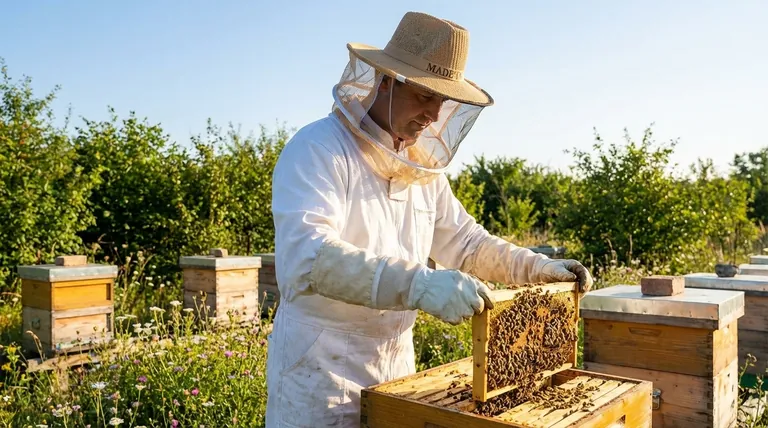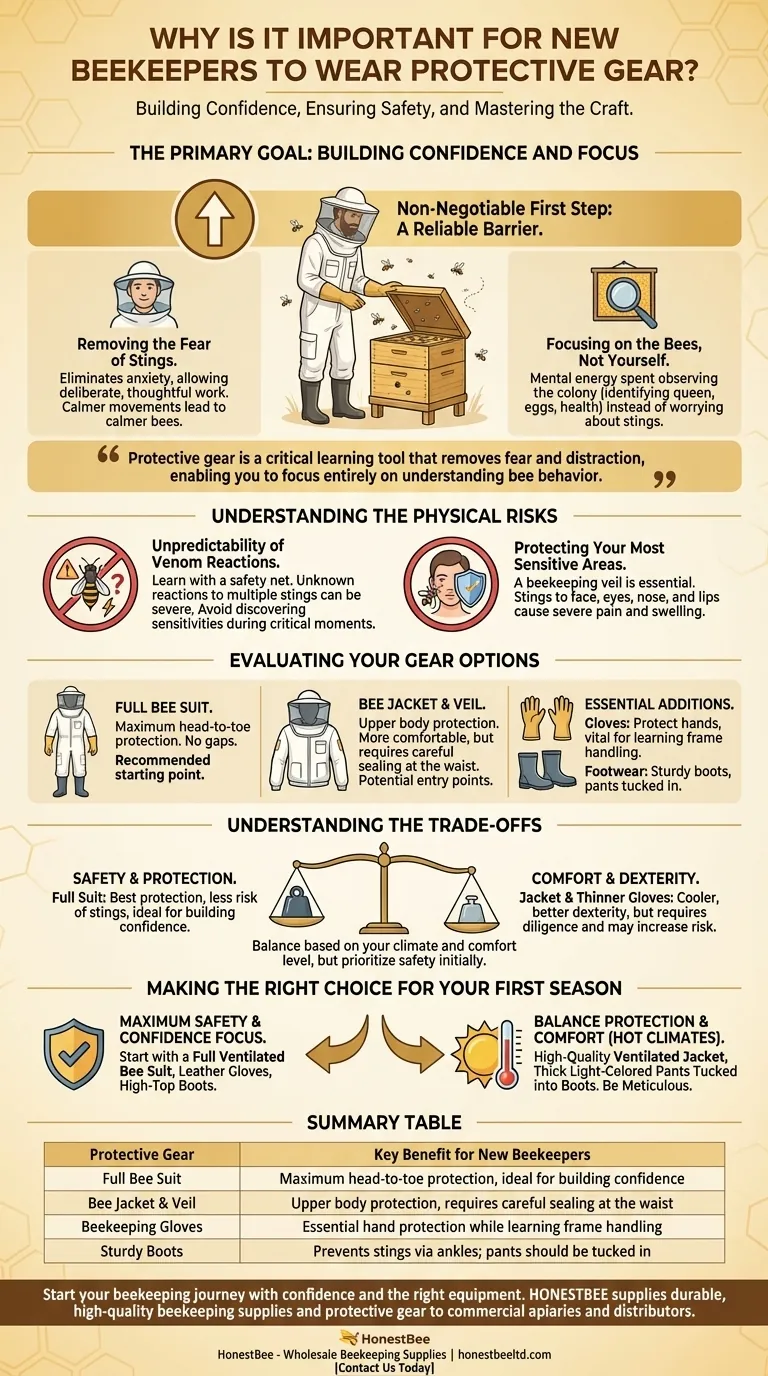For new beekeepers, wearing full protective gear is a non-negotiable first step. Its primary purpose is to provide a reliable barrier against bee stings, which allows you to build confidence, learn to handle bees calmly, and safely understand your body's tolerance to bee venom without undue risk.
The core issue isn't just about avoiding the pain of a sting. Protective gear is a critical learning tool that removes fear and distraction, enabling you to focus entirely on understanding bee behavior and performing hive inspections correctly.

The Primary Goal: Building Confidence and Focus
As a new beekeeper, your greatest asset is a calm demeanor. Protective gear is what makes that possible.
Removing the Fear of Stings
The constant threat of being stung creates anxiety. A full bee suit or jacket with a veil eliminates this primary fear, allowing you to work deliberately and thoughtfully.
When you aren't flinching or making sudden movements, the bees themselves remain calmer, creating a more positive feedback loop for you and the hive.
Focusing on the Bees, Not Yourself
With a reliable barrier, your mental energy can be spent observing the colony. You can focus on identifying the queen, looking for eggs, and assessing the hive's health instead of worrying about a bee landing on your arm.
This undivided attention is crucial for developing the skills needed to become a competent and successful beekeeper.
Understanding the Physical Risks
While most stings are merely painful, the risk of a more severe reaction is real, especially when you are just starting out.
The Unpredictability of Venom Reactions
Even if you have been stung before, you may not know how your body will react to multiple stings—a common risk during a hive inspection gone wrong.
Protective gear allows you to learn beekeeping with a safety net, preventing a situation where you discover a sensitivity or allergy during a critical moment.
Protecting Your Most Sensitive Areas
Stings to the face—especially near the eyes, nose, and lips—are significantly more painful and can cause severe swelling. A beekeeping veil is the most essential piece of gear because it protects your head and face, the most vulnerable targets.
Evaluating Your Gear Options
Your choice of gear depends on balancing total protection with comfort and mobility. For beginners, the scale should always tip toward more protection.
The Full Bee Suit
A full, one-piece suit offers maximum, head-to-toe protection. It ensures there are no gaps between a jacket and pants where bees can enter, providing the highest level of security. This is the recommended starting point for all new beekeepers.
The Bee Jacket
A jacket offers protection for the upper body and typically comes with an attached veil. While more comfortable and easier to put on, it must be paired with thick pants and sealed at the waist to be effective, leaving a potential entry point for bees if not worn correctly.
Essential Additions: Gloves and Footwear
Beekeeping gloves protect your hands, which are in closest contact with the bees. While they can reduce dexterity, they are vital for preventing stings while you learn to manipulate frames. Always tuck your gloves into your sleeves and your pants into sturdy, closed-toe boots.
Understanding the Trade-offs
Every equipment choice comes with benefits and drawbacks. Being aware of them helps you make an informed decision.
Safety vs. Comfort
A full bee suit offers the best protection but can be hot and cumbersome, especially in warm climates. A jacket is cooler but requires more diligence to ensure there are no gaps for bees to crawl into.
Protection vs. Dexterity
Thick leather gloves offer excellent sting protection but make it harder to handle frames gently. This can lead to accidentally rolling or crushing bees, which can agitate the colony. Some beekeepers eventually move to thinner gloves as their confidence grows.
Making the Right Choice for Your First Season
Your initial gear choice should prioritize safety to create a positive and productive learning environment.
- If your primary focus is maximum safety and building confidence: Start with a full, ventilated bee suit, leather gloves, and high-top boots. This removes any doubt and lets you focus on the bees.
- If your primary focus is balancing protection with comfort in a hot climate: A high-quality ventilated jacket paired with thick, light-colored pants tucked into boots is a viable option, but be meticulous about sealing the waistline.
Ultimately, protective gear is the tool that enables you to become a calm, observant, and effective beekeeper.
Summary Table:
| Protective Gear | Key Benefit for New Beekeepers |
|---|---|
| Full Bee Suit | Maximum head-to-toe protection, ideal for building confidence |
| Bee Jacket & Veil | Upper body protection, requires careful sealing at the waist |
| Beekeeping Gloves | Essential hand protection while learning frame handling |
| Sturdy Boots | Prevents stings via ankles; pants should be tucked in |
Start your beekeeping journey with confidence and the right equipment. HONESTBEE supplies durable, high-quality beekeeping supplies and protective gear to commercial apiaries and beekeeping equipment distributors through our wholesale-focused operations. Let us help you equip yourself or your customers for a safe and successful season. Contact us today to discuss your needs!
Visual Guide

Related Products
- Beekeeper Cowboy Hat and Veil for Beekeeping
- Yellow Plastic Bucket Pail Perch for Beekeeping
- HONESTBEE Advanced Ergonomic Stainless Steel Hive Tool for Beekeeping
- Professional 3-Bar Frame Grip with Integrated Hive Tool
- Professional Dual-End Stainless Steel Hive Tool for Beekeeping
People Also Ask
- What are the benefits of the lightweight fabric used in the beekeeping hat veil? Enhanced Visibility & Comfort for Hive Work
- How can beekeeping supplies and accessories enhance the hobby? Essential Tools for Safe & Rewarding Beekeeping
- What is the purpose of a hat and veil in beekeeping? Essential Protection for Head & Face
- What activities is the beekeeping hat suitable for? Beyond the Hive for Ultimate Outdoor Protection
- How does the design of the beekeeping hat ensure comfort during extended use? Maximize Comfort for Long Apiary Hours



















